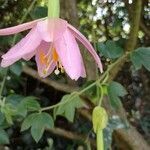Vigorous vine; shoots densely hairy, weakly angular when young. Lvs 3-lobed; petioles 1.5-5 cm long, densely hairy, with (4)-6-12 stalked or subsessile glands; stipules 5-10 mm wide (excluding subulate apex when present), subreniform, with glandular teeth; lamina lobes usually 5-14 cm long, extending 1/2-⅔ of the distance in from the margin, usually ± tomentose below, hairy or glabrate above, elliptic or elliptic-ovate, narrow-lanceolate on juvenile shoots, serrate or serrulate, acute; middle lobe largest, 4-9 × 2-5 cm. Fls ☿, solitary. Pedicels > petioles, densely hairy. Bracts 1.5-3.75 cm long, ovate or broad-ovate, ± tomentose outside, entire or slightly toothed, united for lower 1/4-1/2 until anthesis. Hypanthium 8-9.5 cm long, glabrous outside. Sepals 2-3.8 cm long, elliptic, green on reverse, pink or rose inside, rounded and with short horn near apex; petals similar but pink on both sides; corona a ring of purple, white-tipped scales 1-2 mm long. Filaments 1.5-2 cm long, pale, often scarcely > anthers; anthers (7)-10-12 mm long. Ovary white-villous. Fr. (6)-7-12 × 2-3 cm, ± ellipsoid, yellow or orange-yellow, puberulent; pulp sweet and orange, edible. Seed 4.5-5.5 mm long, broad-obovoid, dark red to black, alveolate.
Leaf-lamina 5–10 × 6–12 cm., 3(5)-lobed to c. 2/3 of its length, the lobes 3–4 cm. broad, ovate or ovate-oblong, acute, the sinuses also acute, sharply serrate-dentate and glandular at margin, subcordate at the base, membranous, softly pubescent above, greyish-or yellowish-tomentose beneath; petiole up to 3 cm. long, canaliculate, with 8–12 small sessile glands near the margin; stipules 7–9 × 3–4 mm., subreniform, aristate, denticulate or subentire.
A vigorous vine. It has a leaf with 3 lobes. The vine has tendrils by which it attaches to other plants. The flowers are pink and about 7.5 cm across. The fruit is long and yellow, 5-12 cm long x 3-4 cm diameter. It contains several hard black seeds.
Calyx-tube 6·5–8 cm. long, c. 1 cm. in diameter, glabrous, rarely pubescent, olive-green, often red outside, white inside.
Bracts 2·5–3 cm. long, united for 1/2 to 3/4 their length, acute at apex, entire-margined, softly tomentose.
Fruit 6–7 × 3–3·5 cm., oblong-ovoid, green when unripe, orange-yellow when ripe, softly pubescent.
Stems terete, densely and softly yellow-tomentose; internodes 4–5 cm. or more long.
Corona consisting of a purple band with a few pinkish tubercles or crenulations.
Sepals 2·5–5·5 × 1–1·5 cm., oblong, obtuse, shortly horned below the apex.
Bracts to 4 cm, connate up to halfway; fruit ellipsoid, 7-12 cm, edible.
Herbaceous perennial climber reaching to 20 m., with pendulous flowers.
Seeds up to 6 × 5 mm., broadly obovate, asymmetrical, reticulate.
Operculum white, recurved at the margin, subentire.
Petals almost as long as the sepals, obtuse, pink.
Ovary 9 × 3 mm., oblong, sericeous-tomentose.
Peduncle 2–6 cm. long.

